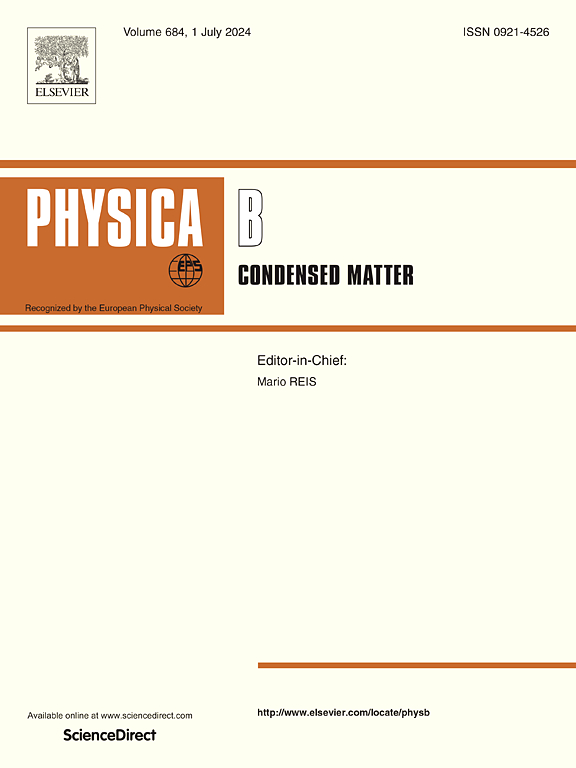硬/软交换耦合双层中界面原子相互扩散对成核场和能积的影响:一维微磁方法
IF 2.8
3区 物理与天体物理
Q2 PHYSICS, CONDENSED MATTER
引用次数: 0
摘要
将一维(1D)分析模型扩展到具有界面层的硬/软交换耦合双层的磁性,重点研究了SmCo/Fe和Nd2Fe14B/Fe体系。结果表明:增大界面层厚度ti增强了成核场HN,从而增大了最大能积(BH)max,同时减小了钉扎场HP;对于平行SmCo(20 nm)/Fe(10 nm)双分子层,1D模型预测的磁性能随ti的增加而变化,与较高退火温度下的实验结果一致。互补三维(3D)微磁模拟证实,在较大的界面交换能常数范围内,HN随ti的增加而增加,这与在所研究的ti范围内的一维计算结果非常吻合。同时,对于每一特定ti, HN也随着界面交换耦合系数的增大而增大。研究结果表明,适当的界面原子扩散增强了软硬相之间的交换耦合效应,提高了磁性能。一维模型还确定了两种系统中最大化(BH)max的最佳界面层厚度。一维模型中垂直Nd2Fe14B/Fe双层的消磁曲线与三维仿真结果吻合,验证了模型的准确性。重要的是,这项工作中建立的一维模型也适用于每层具有不同厚度和磁性参数的硬/软交换耦合三层。与我们之前的设计相反,假设原子从硬相扩散到软相,导致界面层位于软相一侧,本研究考虑两相之间的相互扩散,界面层在两者之间对称分布。本文章由计算机程序翻译,如有差异,请以英文原文为准。
The effect of the interface atomic interdiffusion on the nucleation field and energy product in hard/soft exchange-coupled bilayers: A one-dimensional micromagnetic approach
A one-dimensional (1D) analytical model is extended to study the magnetic properties of hard/soft exchange-coupled bilayers with the interface layer, focusing on SmCo/Fe and Nd2Fe14B/Fe systems. The results show that increasing the interface layer thickness ti enhances the nucleation field HN, thereby increasing the maximum energy product (BH)max, while simultaneously reducing the pinning field HP. For parallel SmCo(20 nm)/Fe(10 nm) bilayers, magnetic property changes with increasing ti predicted by the 1D model align well with experiments at higher annealing temperatures. Complementary three-dimensional (3D) micromagnetic simulations confirm that HN increases with ti over a wide range of interface exchange energy constants, which shows in excellent agreement with the 1D calculated results over the investigated ti range. Meanwhile, HN also increases with the interface exchange coupling coefficient for each specific ti. These findings indicate that appropriate interface atomic interdiffusion enhances the exchange coupling effect between the hard and soft phases and improves magnetic performance. The 1D model also identifies optimal interface layer thicknesses for maximizing (BH)max in both systems. Additionally, demagnetization curves of perpendicular Nd2Fe14B/Fe bilayers from the 1D model match 3D simulation results, verifying the model's accuracy. Importantly, the 1D model developed in this work is also applicable to hard/soft exchange-coupled trilayers with varying thicknesses and magnetic parameters in each layer. In contrast to our previous design, where atoms were assumed to diffuse from the hard phase into the soft phase, resulting in the interface layer being located on the soft phase side, this study considers mutual diffusion between the two phases, with the interface layer symmetrically distributed between them.
求助全文
通过发布文献求助,成功后即可免费获取论文全文。
去求助
来源期刊

Physica B-condensed Matter
物理-物理:凝聚态物理
CiteScore
4.90
自引率
7.10%
发文量
703
审稿时长
44 days
期刊介绍:
Physica B: Condensed Matter comprises all condensed matter and material physics that involve theoretical, computational and experimental work.
Papers should contain further developments and a proper discussion on the physics of experimental or theoretical results in one of the following areas:
-Magnetism
-Materials physics
-Nanostructures and nanomaterials
-Optics and optical materials
-Quantum materials
-Semiconductors
-Strongly correlated systems
-Superconductivity
-Surfaces and interfaces
 求助内容:
求助内容: 应助结果提醒方式:
应助结果提醒方式:


